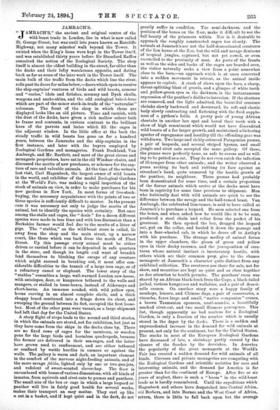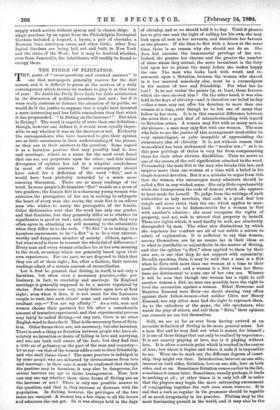JAMRACH'S.
AMRACH'S," the ancient and original centre of the tJ wild-beast trade in London, lies in what is now called St. George Street, but was until late years known as Ratcliffe Highway, not many minutes' walk beyond the Tower. It existed when the King's lions were kept in the Tower itself, and was established thirty years before Sir Stamford Raffles conceived the notion of the Zoological Society. The shop itself is almost the oldest building in the street, far older than the docks and their lofty warehouses opposite, and dating 'ack as far as some of the later work in the Tower itself. The main bulk of the traffic from the docks which line the river, rolls past its doors for miles below,—doors which open to receive the ship-captains' ventures of birds and wild beasts, armour and " curios," idols and fetishes, mummy and Dyak skulls, weapons and snake-skins, and the odd zoological brit-l-brat which are part of the minor stock-in-trade of the "naturalist" salesman. The front of the shop in which these are displayed looks like an old picture. Time and varnish, with the dust of the docks, have given a rich mellow colour both to frame and contents, in curious contrast to the brilliant hues of the parrots and lories which fill the cages in -the adjacent window. In the little office at the back the steady traffic in wild beasts has gone on for a hundred years, between the Jamrachs and the ship-captains in the first instance, and later with the buyers employed by Zoological Gardens and menageries. Frank Buckland, Van Ambnrgh, and Mr. Bartlett, and most of the great circus and menagerie proprietors, have sat in the old Windsor chairs, and discussed the merits of new purchases, or schemes for the cap- ture of rare and valuable animals. At the time of the writer's last visit, Carl Hagenbeck, the largest owner of wild beasts in the world, and exhibitor of the model Zoological Gardens at the World's Fair, was making a rapid inspection of the stock of animals on view, in order to make purchases for his new gardens in New York. In most forma of live-stock- buying, the necessary acquaintance with the points of two or three species is sufficiently difficult to master. In the present -ease it was necessary not only to judge the merits of the animal, but to identify the species with certainty. But once among the stalls and cages, the " deals " for a dozen different species were made in less time and with less discussion than a Berkshire farmer would feel due to the merits of a litter of pigs. The " stables," as the wild-beast store is called, lie away from the shop and the main street, up a narrow court, like those which run back from the north of Fleet Street. Up this passage every animal must be either driven or carried before it can be deposited in safe quarters in the store, and though its length and want of breadth lend themselves to blocking the escape of any creature which might succeed in breaking out, it must offer con- siderable difficulties to the transit of a large iron cage, or of a refractory camel or elephant. The lower story of the " stables " resembles a large, well-warmed London cow-house, with antelopes, deer, or kangaroos tethered to the walls and mangers, or stalled in loose-boxes, instead of Alderneys and short-horns. An immense aoudad, with wild yellow eyes, horns curving in an almost complete circle, and a, thick shaggy beard continued into a fringe down its chest, and sweeping the ground between its feet, occupied the first loose- box. Most of the other pens were vacant, as a large shipment had left that day for the United States.
A steep flight of steps leads to the second and third stories, 'in which the animals are stored, not for exhibition, but just as they have come from the ships in the docks close by. There are no fixed rows of cages for the carnivora, or wooden pens for the large birds and harmless quadrupeds, because the former are delivered in their sea-cages, and the latter have grown used to confinement, and are either tethered or confined by wattle hurdles in corners or against the walls. The gallery is warm and dark, an important element in the comfort of the nervous night-feeding animals, and of the more savage felidz, lighted only by one or two gas-jets, and redolent of sweet-scented clover-hay. The floor is encumbered with boxes of various dimensions, with all kinds of inmates, from squirrels and civet-cats to pumas and panthers, The small size of the box or cage in which a large leopard or panther will live in fairly good health for several weeks, makes their transport an easy matter. They curl up like a eat in a basket, and if kept quiet and in the dark, do not greatly suffer in condition. The semi-darkness, and the position of the boxes on the floor, make it difficult to see the full beauty of the prisoners within. Nor is it desirable to approach the roughly constructed cages too closely. The animals at Jamrach's are not the half-domesticated creatures of the lion house at the Zoo, but the wild and savage denizens of tropical jungles, captured, but not yet cowed, or even reconciled to the proximity of man. As parts of the fronts as well as the sides and backs of the cages are boarded over, the visitor naturally seeks a view from a point somewhat close to the bars,—an approach which is at once converted into a sudden movement in retreat, as the animal inside appears to explode. A crash of claws upon the bars, a sharp, throat-splitting blast of growls, and a glimpse of white teeth and yellow-green eyes in the darkness, is the instantaneous expression of the panther's dislike to intrusion. If the shutters are removed, and the light admitted, the beautiful creature shrinks slowly backward and downward, its soft and elastic body slowly contracting and flattening with the fluid supple- ness of a python's folds. A pretty pair of young African cheetahs in another box spat and bared their teeth with a show of high resentment which would not have discredited wild beasts of a far larger growth, and maintained a bickering sputter of repugnance and hostility till the offending gaze was withdrawn. Two large and richly coloured Patagonian pumas, a pair of leopards, and several striped hyenas, and small jungle and civet cats occupied the same gallery. Of these, the pumas were perfectly tame, as safe to caress and as will- ing to be petted as a cat. They do not even catch the infection of ill-temper from other animals ; and the writer observed a puma arching its back and robbing its face against an attendant's hand, quite unmoved by the hostile growls of the panther, its neighbour. These pumas had probably been domesticated for some time, and a certain proportion of the fiercer animals which arrive at the docks must have been in captivity for some time previous to shipment. Men who habitually deal with wild animals are quick to see the difference between the savage and the half-tamed beast. Van Ambnrgh, the celebrated lion-tamer, is said to have called at Jamrach's to purchase a leopard. He soon selected one from the boxes, and when asked how he would like it to be sent, produced a steel chain 'and collar from the pocket of his greatcoat. He then opened the box, dragged the leopard out, put on the collar, and hauled it down the passage and into a four-wheeled cab, in which he drove off to Astley's with his purchase. The strange medley of animal forms in the upper chambers, the gleam of green and yellow eyes in their dusky recesses, and the juxtaposition of crea- tures whose natural instinct is inveterately hostile, with others which are their common prey, give to the chance menagerie at Jamrach's a character quite distinct from any exhibited collection. The creatures are there for sale, not for show, and meantime are kept as quiet and as close together as due attention to health permits. The panthers' room was shared by an African black-buck from the Cape, a black-tailed jackal, various kangaroos and wallabies, and a pair of demoi- selle cranes. On another story were a happy family of monkeys, lemurs, and Chinese dogs, a pair of cassowaries, a viscacha, foxes large and small, "native companion" cranes, a brown Tasmanian opossum, coati-mundis, a beautifully marked civet-cat, and two small Siamese porcupines. This list, though apparently no bad nucleus for a Zoological Garden, is only a fraction of the number which is usually stored in the depot by the docks. There is a sudden and unprecedented increase in the demand for wild animals at present, not only for the continent, but for the United States. The stocks in most of the European Zoological Gardens have decreased of late, a shrinkage partly caused by the closure of the Soudan by the dervishes. In America the popularity of the great menagerie at the World's Fair has created a sudden demand for wild animals of all kinds. Circuses and private menageries are competing with the Zoological Gardens and scientific societies for rare and interesting animals, and the demand 5or America is far greater than for the continent of Europe. After five or six years of neglect, there is such a "boom" in the wild-beast trade as is hardly remembered. Until the expeditions which Hagenbeck and others have despatched into Central Africa, vid, Berbera, and into Borneo and the West Coast of Africa, return, there is little to fall back upon but the average
supply which arrives without system and in chance ships. A single purchase by an agent from the Philadelphia Zoological Gardens included a leopard, a hyena, a pair of cheetahs, a Bornean bear, antelopes, emus, and other birds; other Zoo- logical Gardens are being laid out and built in New York and the cities of the West; but it may be doubted whether, even from Jamrach's, the inhabitants will readily be found to occupy them.



































 Previous page
Previous page